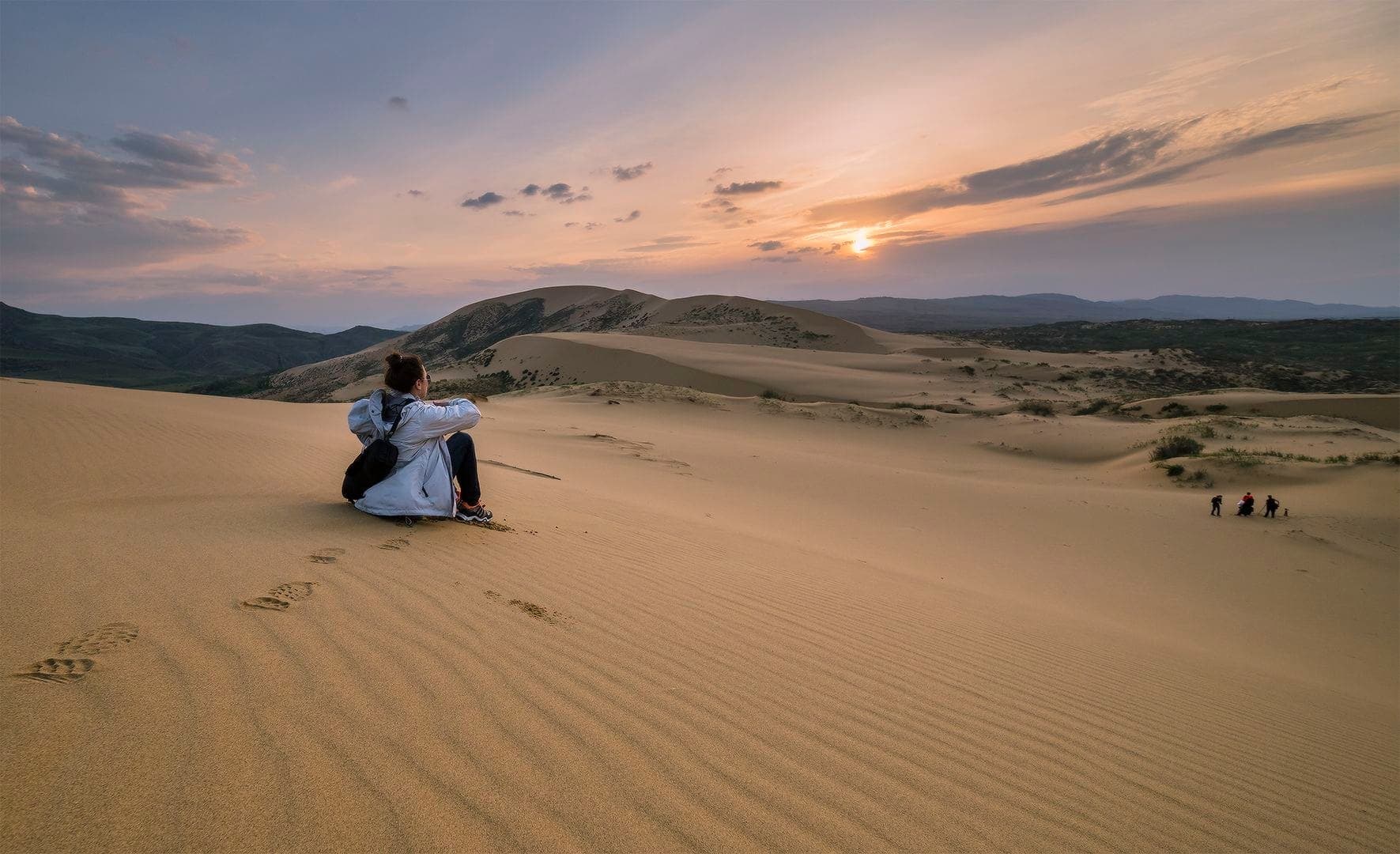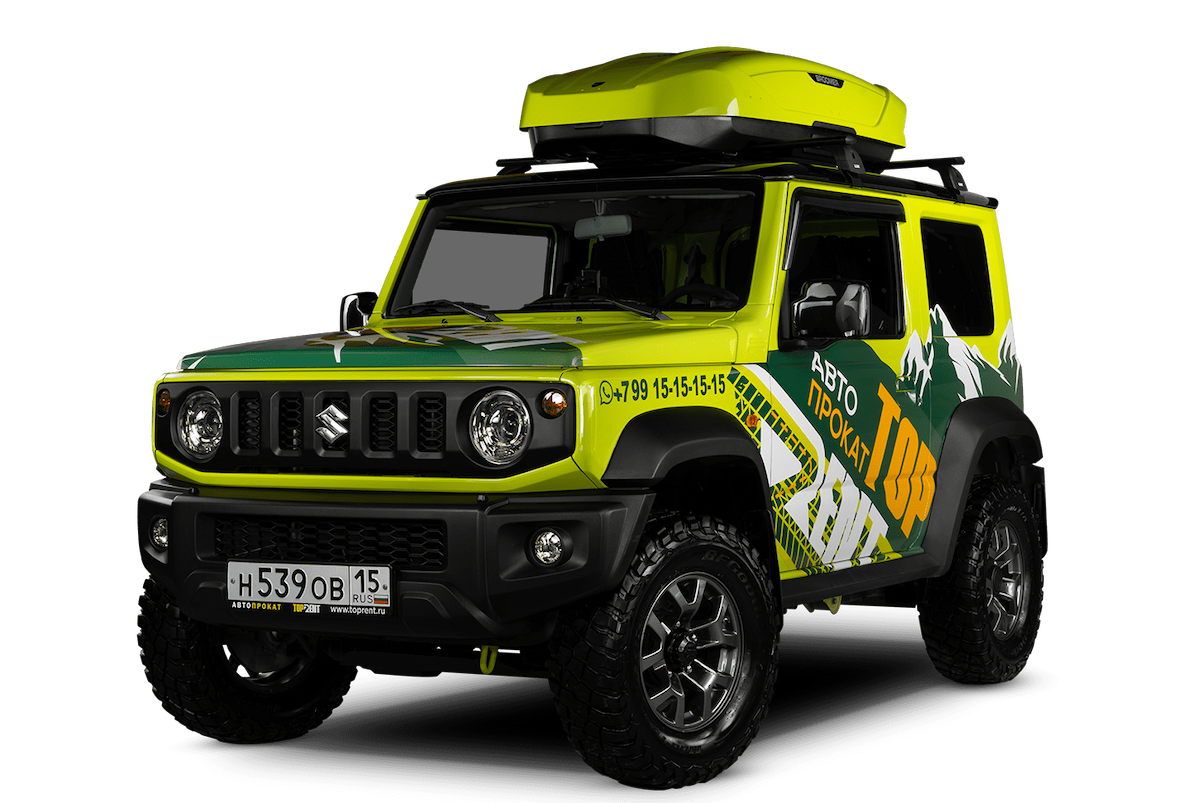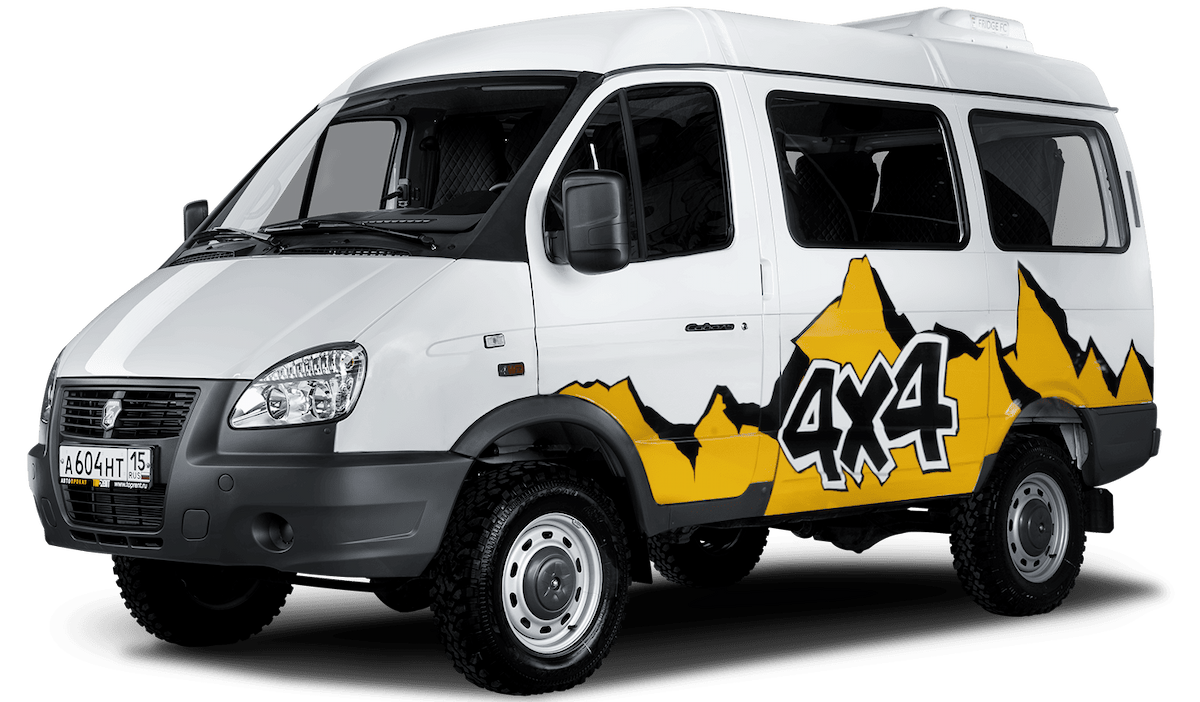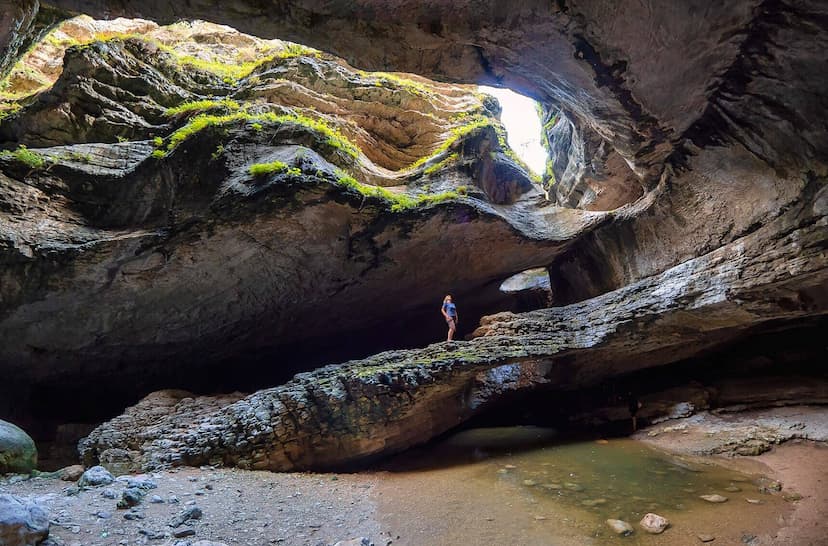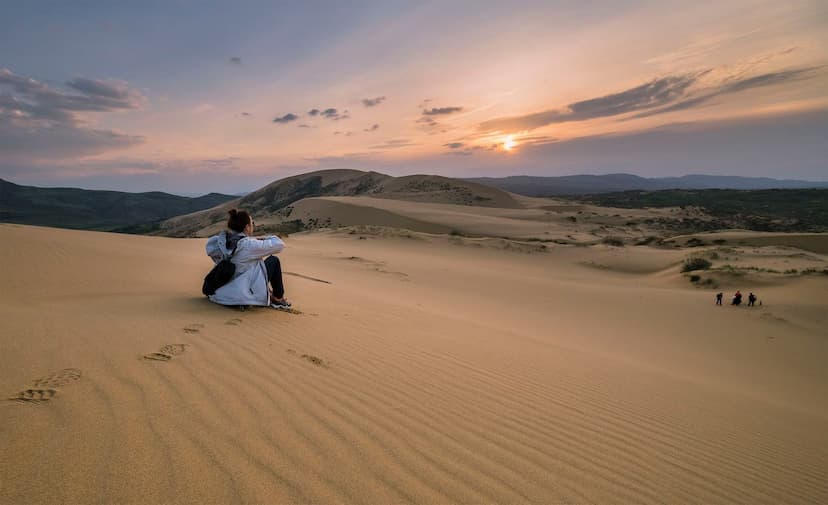Sarykum barkhan (Sary-Kum) is the largest sand barkhan in Europe. Its area reaches almost 4 km2. It is a real desert, where anyone can visit without leaving the country. This is really possible: even in translation from Kumyk the name of the object is translated as “yellow sands”, which fully reflects the natural essence of the sight.
Briefly about the history of the barchan
First of all, a quite natural question arises: “How could such a barchan be formed at all?”. And even such a significant size, 3 km long and 2 km wide. And in general, how can there be a barchan not in the desert? And how can a river flow through it?
If we talk about the history of the origin of the Sarykum dune, it is believed that its formation is due to the winds that have been blowing sand from different directions onto this place for centuries. That is, the dune was formed as a result of the collision of winds that carried sand from the scattered river terraces. The sand itself appeared as a consequence of wind destruction of sandstones of the surrounding rocks of the Kapchagai gorge.
According to available data, the age of the barkhan reaches 5000 years. In 1978, it was included in the list of natural monuments, and in 1987 it was added to the Dagestan Nature Reserve and made a protected area.
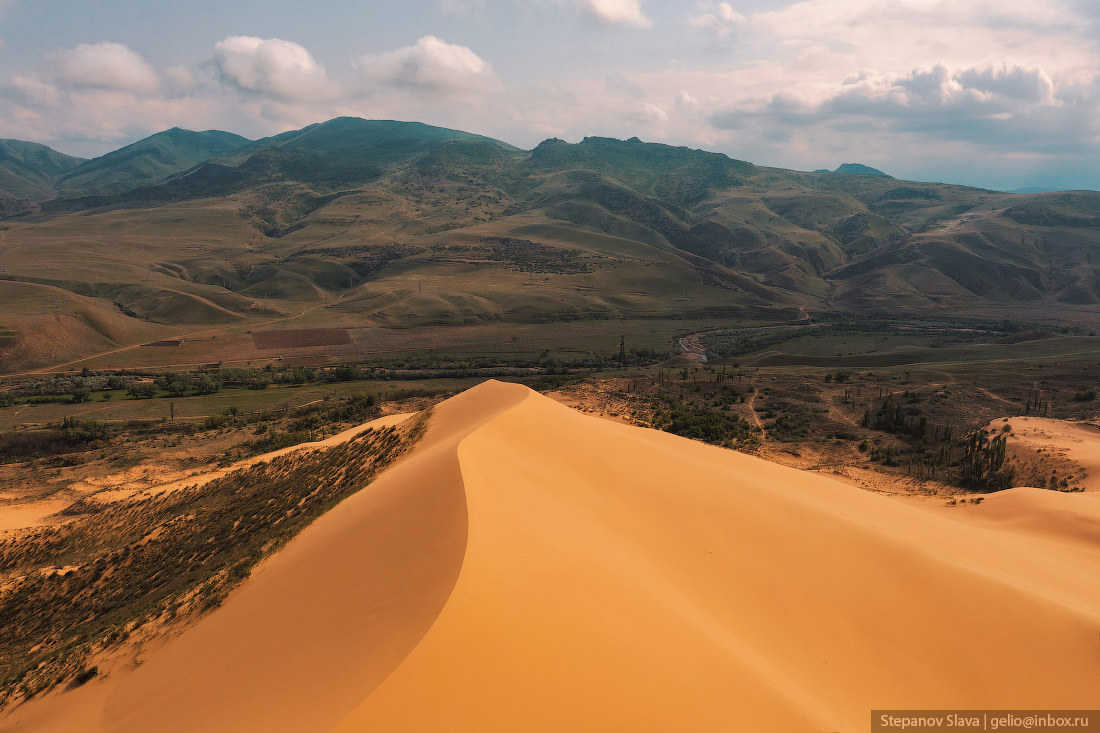
Interesting facts and legends
Barkhan Sarykum is an amazingly beautiful place, literally living its own life, full of flora and fauna. You can tell a lot about this natural attraction. According to different data, the Sarykum sand barchan has a height ranging from 244 to 262 meters. This makes it one of the highest in the world.
What is even more interesting is that this barchan is not like the others. The miracle is that it does not move under the wind, which is typical of any barchan. Sarykum stands in place as if it were a stumbling block. Only the tops move, and the whole dune remains motionless. These are the winds that bring sand from all around and do not take it back.
Unique climate
Another peculiarity is the climate. French winemakers who visited here a few years ago even advised to plant vineyards near the barchan. All because the climatic conditions here are ideal for this. At the same time, the barkhan itself found its place in the zone, which is not suitable for desert. And this is truly surprising.
On the barkhan and adjacent territories there is a dry arid climate, which is typical for deserts. The average annual temperature is +14.8 °C. At the same time, the barkhan area is the only one in Dagestan where the average daily temperature exceeds 20 °C for 5 months of the year.
On the southern slopes in summer the heat can reach 60 °C. The peak is in August and the minimum is in February. The sand warms up to +30 °C already in the middle of spring. Although at night it absorbs moisture from the atmosphere and becomes cold.
Filming of a famous movie
The famous movie “White Sun of the Desert” was filmed on the Sarykum sand barchan in 1968. In particular, one of the scenes when the main character soldier Sukhov rescued a local resident Said, buried up to his neck in the sand by a bandit.
Those who watched the movie could hardly think that it was filmed not somewhere in the sands of Turkestan. And indeed, everyone who has been here can feel that he has teleported somewhere in the Sahara. The transverse dunes of the barchan reach a huge height, so you can see neither neighboring mountains nor the sea behind them. This is exactly what the film crew used. And today you already know that Comrade Sukhov rescued Said and Abdullah's harem just 20 kilometers from Makhachkala.
Legends about the origin
In an attempt to explain the origin of the dune, legends began to be written about it. According to one of them, the dune is the grave of the mythical giant Zamti; according to another, the Kumtorkal Khan chained his unfaithful wife Zagidat here and covered her with sand.
According to the third legend, the sand was poured by Tamerlane's soldiers when he asked them to scoop it into their helmets and pour it into the specified place. In this way, the conqueror wanted to make sure that he had enough forces at his command for the attack of Tokhtamysh, the Khan of the Golden Horde.
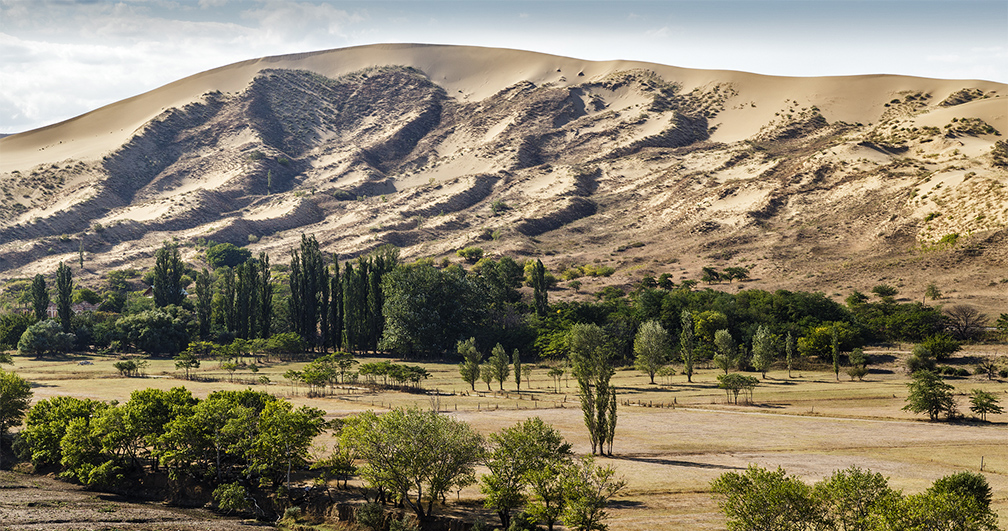
Nature of Sarykum barkhan
Due to the climatic peculiarities of the Sarykum barkhan reserve a variety of biotopes have been formed. These are not only huge sandy massifs, but also steppes, sparse forests and thickets. There are more than 350 different plants, 30 species of mammals and 200 types of birds, including the steppe eagle, golden eagle and owl, which are included in the Red Book.
The Mediterranean tortoise Testudo graeca, which belongs to rare species and is under protection, also lives here. It is quite realistic to meet it. But be careful, because the turtle is not too big, only 20-30 cm. Besides it, here you can see the largest grasshopper of Russia - steppe dybka, and also Caspian stripe and even scorpion, tarantula or scolopendra.
The Shura-Ozen River, which flows right through the barchan, leaves no less impressions. It divides it into two parts: the big one - the left bank, the small one - the right bank. Here you can get inspired, enjoy picturesque views and make cool photos in the desert.
How to get to the Sarykum barkhan
Sarykum barkhan is located only 30 km away from Makhachkala, the capital of Dagestan. To visit it you will need to take a permit at the cordon from the specialist on duty. Entrance to the territory is paid, but the cost is quite symbolic - 128 rubles for an adult. You can also visit the Museum of Nature near the barchan - the ticket costs 100 rubles for an adult and 50 rubles for school-age children. Near the reserve you can find accommodation in the form of guest houses and equipped carriages.
On the map we have presented the route how to get to the Sarykum barchan in Dagestan, if you are traveling from Vladikavkaz. Be sure to take a snack and water with you, as there are no cafes or stores in the reserve itself. There are metal and boardwalks to move around the territory, and at the very top of the tourist trail there is a viewing platform.
The most convenient way to get there from Vladikavkaz is by car. It is best for tourists to rent a car. This way you can enjoy the road itself, and if you wish, you can visit Makhachkala, where you can take a guide who will show you the barchan itself, and the abandoned railway station near it, and the picturesque Kapchugai Gorge, breaking out of the foothills into the plain of the Shura-Ozen River, and the distant Caspian Sea.
Besides, by rented car you can visit other sights of the republic, for example, the Sulak Canyon, which is even deeper than the famous Grand Canyon. Despite the difficult roads to this object, you can easily get to any point on a rented Suzuki Jimny or other similar car. Take advantage of this unique chance and you will be able to see with your own eyes the beautiful barchan, which formed as if by itself and remains in the same place for several thousand years.

